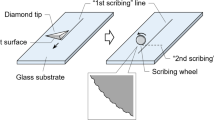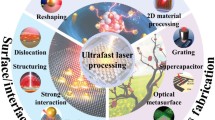Abstract
The glass surfaces used for optical devices are necessary to have high transparency. Here we propose to take advantage of tube-like Si02 textures to trap lubricant liquid inside aiming to prepare novel slippery liquid-infused porous surfaces (SLIPS). As a consequence, SLIPS with high transparency were synthesized on glass substrate successfully. The capillary action of unique tubular structure induces the ion migration of adjacent Krytox 100, thus endowing SLIPS with the self-healing property. Moreover, the remarkable slip behavior enables these surfaces to possess the self-cleaning and anti-biofouling performances. The current work might provide a promising candidate for long-term transparent optical devices.





Similar content being viewed by others
References
L. Zhang, C.-H. Xue, M. Cao, M.-M. Zhang, M. Li, and J.-Z. Ma: Highly transparent fluorine-free superhydrophobic silica nanotube coatings. Chem. Eng. J. 320, 244 (2017).
K. Golovin, D.H. Lee, J.M. Mabry, and A. Tuteja: Transparent, flexible, superomniphobic surfaces with ultra-low contact angle hysteresis. Angew. Chem. Int. Ed. 52, 13007 (2013).
W. Barthlott and C. Neinhuis: Purity of the sacred lotus, or escape from contamination in biological surfaces. Planta 202, 1 (1997).
P. Dimitrakellis and E. Gogolides: Hydrophobic and superhydrophobic surfaces fabricated using atmospheric pressure cold plasma technology: a review. Adv. Colloid Interface Sci. 254, 1 (2018).
W. Wang, Y.-Q. Liu, Y. Liu, B. Han, H. Wang, D.-D. Han, J.-N. Wang, Y.-L. Zhang, and H.-B. Sun: Direct laser writing of superhydrophobic PDMs elastomers for controllable manipulation via Marangoni effect. Adv. Funct. Mater. 27, 1702946 (2017).
X. Tang and L. Wang: Loss-free photo-manipulation of droplets by pyroelectro-trapping on superhydrophobic surfaces. ACS Nano 12, 8994 (2018).
V. Jokinen, E. Kankuri, S. Hoshian, S. Franssila, and R.H.A. Ras: Superhydrophobic blood-repellent surfaces. Adv. Mater. 30, 1705104 (2018).
L. Feng, S. Li, Y. Li, H. Li, L. Zhang, J. Zhai, Y. Song, B. Liu, L. Jiang, and D. Zhu: Super-hydrophobic surfaces: from natural to artificial. Adv. Mater. 14, 1857 (2002).
X. Tian, S. Shaw, K.R. Lind, and L. Cademartiri: Thermal processing of silicones for green, scalable, and healable superhydrophobic coatings. Adv. Mater. 28, 3677 (2016).
G.B. Hwang, K. Page, A. Patir, S.P. Nair, E. Allan, and L.P. Parkin: The anti-biofouling properties of superhydrophobic surfaces are short-lived. ACS Nano 12, 6050 (2018).
L. Bocquet and E. Lauga: A smooth future? Nat Mater. 10, 334 (2011).
R. Poetes, K. Holtzmann, K. Franze, and U. Steiner: Metastable underwater superhydrophobicity. Phys. Rev. Lett. 105, 166104 (2010).
D. Quéré: Wetting and roughness. Annu. Rev. Mater. Res. 38, 71 (2008).
R.G. Karunakaran, C.-H. Lu, Z. Zhang, and S. Yang: Highly transparent superhydrophobic surfaces from the coassembly of nanoparticles (≤100 nm). Langmuir 27, 4594 (2011).
F. Li, M. Du, Z. Zheng, Y. Song, and Q. Zheng: A facile, multifunctional, transparent, and superhydrophobic coating based on a nanoscale porous structure spontaneously assembled from branched silica nanoparticles. Adv. Mater. Interfaces 2, 1500201 (2015).
T.-S. Wong, S.H. Kang, S.K. Tang, E.J. Smythe, B.D. Hatton, A. Grinthal, and J. Aizenberg: Bioinspired self-repairing slippery surfaces with pressure-stable omniphobicity. Nature 477, 443 (2011).
M. Zhang, Q. Liu, R. Chen, H. Chen, D. Song, J. Liu, H. Zhang, R. Li, Y. Wang, and J. Wang: Lubricant-infused coating by double-layer ZnO on aluminium and its anti-corrosion performance. J. Alloys Compd. 764, 730 (2018).
I. Oh, C. Keplinger, J. Cui, J. Chen, G.M. Whitesides, J. Aizenberg, and Y. Hu: Dynamically actuated liquid-infused poroelastic film with precise control over droplet dynamics. Adv. Funct. Mater. 28, 1802632 (2018).
P. Zhang, G. Liu, D. Zhang, and H. Chen: Liquid-infused surfaces on elec-trosurgical instruments with exceptional antiadhesion and low-damage performances. ACS Appl. Mater. Interfaces 10, 33713 (2018).
M. Liu, Y. Hou, J. Li, L. Tie, and Z. Guo: Transparent slippery liquid-infused nanoparticulate coatings. Chem. Eng. J. 337, 462 (2018).
K. Rykaczewski, S. Anand, S.B. Subramanyam, and K.K. Varanasi: Mechanism of frost formation on lubricant-impregnated surfaces. Langmuir 29, 5230 (2013).
Y. Lu, S. Sathasivam, J. Song, C.R. Crick, C.J. Carmalt, and I. P. Parkin. Robust self-cleaning surfaces that function when exposed to either air or oil. Science 347, 1132 (2015).
C. Jia, J. Song, Y. Jin, and O.J. Rojas: Controlled-release drug carriers based hierarchical silica microtubes templated from cellulose acetate nanofibers. J. Appl. Polym. Sci. 132, 38 (2015).
F. Ambroz, T.J. Macdonald, V. Martis, and L.P. Parkin: Evaluation of the bet theory for the characterization of meso and microporous MOFs. Small Methods 0, 1800173 (2018).
H. Chen, P. Zhang, L. Zhang, H. Liu, Y. Jiang, D. Zhang, Z. Han, and L. Jiang: Continuous directional water transport on the peristome surface of Nepenthes alata. Nature 532, 85 (2016).
Y. Wei, Z. Tian, H. Gies, R. Xu, H. Ma, R. Pei, W. Zhang, Y. Xu, L. Wang, and K. Li: Inside cover: ionothermal synthesis of an aluminophosphate molecular sieve with 20-ring pore openings. Angew. Chem., Int. Ed. 49, 5200 (2010).
C. Ishino, M. Reyssat, E. Reyssat, K. Okumura, and D. Quere: Wicking within forests of micropillars. Europhys. Lett. 79, 56005 (2007).
Acknowledgments
This work was supported by the National Natural Science Foundation of China (No. 51603053), the Application Technology Research and Development Plan of Heilongjiang Province (GX16A008), the Fundamental Research Funds of the Central University and the Application Technology Research and Development Projects of Harbin (2015RAQXJ038), Defense Industrial Technology Development Program (JCKY2016604C006) and National Key R&D Program of China (2016YFE0202700).
Author information
Authors and Affiliations
Corresponding author
Supplementary material
Supplementary material
The supplementary material for this article can be found at https://doi.org/10.1557/mrc.2018.241
Rights and permissions
About this article
Cite this article
Zhang, M., Liu, Q., Liu, J. et al. Self-healing liquid-infused surfaces with high transparency for optical devices. MRS Communications 9, 92–98 (2019). https://doi.org/10.1557/mrc.2018.241
Received:
Accepted:
Published:
Issue Date:
DOI: https://doi.org/10.1557/mrc.2018.241




